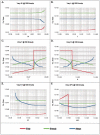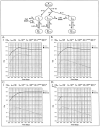A computerized model for the self-non-self discrimination at the level of the T(h) (Th genesis). II. The behavior of the system upon encounter with non-self antigens
- PMID: 12697660
- PMCID: PMC1457092
- DOI: 10.1093/intimm/dxg059
A computerized model for the self-non-self discrimination at the level of the T(h) (Th genesis). II. The behavior of the system upon encounter with non-self antigens
Abstract
In the final analysis, the self (S)-non-self (NS) discrimination is regulated by the sufficiency or insufficiency of effector T(h) (eT(h)) specific for the given antigen. We have described a model (Th genesis) for the origin of eT(h) based on an antigen-independent pathway from initial state T(h) (iT(h)) to eT(h), and on obligatory associative recognition of antigen (ARA) by an iT(h) and an eT(h) in order for the iT(h) to be activated. A computer analysis (referred to as Th genesis) was developed to evaluate this model that is extended here to describe the response to NS antigen. Th genesis fills in the missing element of the two-signal or ARA model for the S-NS discrimination, i.e. the origin of the primer eT(h). The conclusions from this analysis are compared with those of the other models for the origin of eT(h).
Figures









References
-
- Langman RE, Cohn M. A minimal model for the self—non-self discrimination: a return to the basics. Semin. Immunol. 2000;13:189. - PubMed
-
- Langman RE, Cohn M. If the immune repertoire is large, random, and somatically generated, then... Cell. Immunol. 2002;216:15. - PubMed
-
- Janeway CA. The immune system evolved to discriminate infectious non-self from noninfectious self. Immunol. Today. 1992;13:11. - PubMed
-
- Janeway CA, Goodnow CC, Medzhitov R. Immunological tolerance: danger—pathogen on the premises! Curr. Biol. 1996;6:519. - PubMed
MeSH terms
Substances
Grants and funding
LinkOut - more resources
Full Text Sources
Miscellaneous

